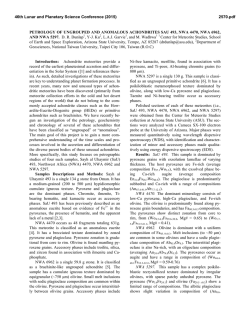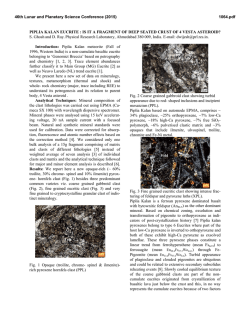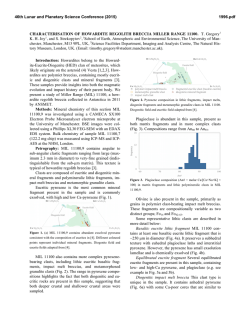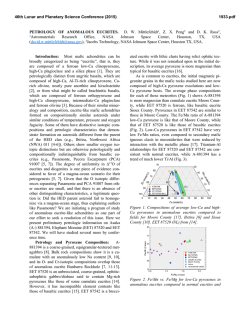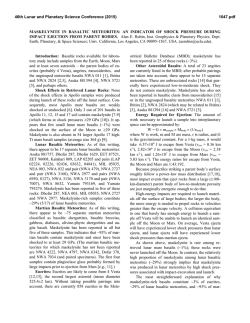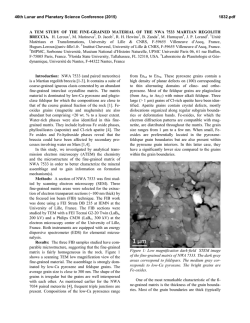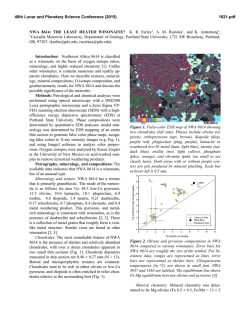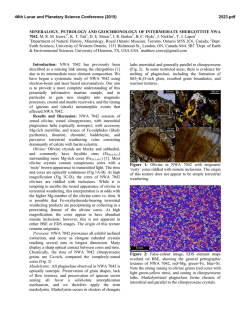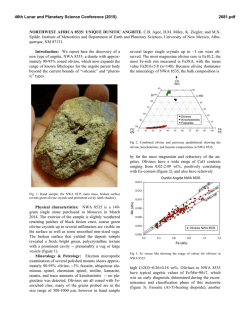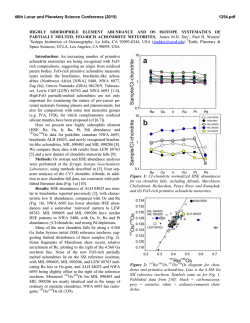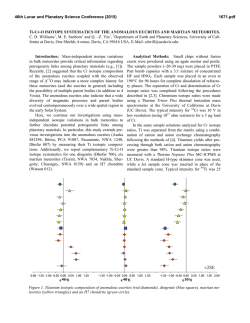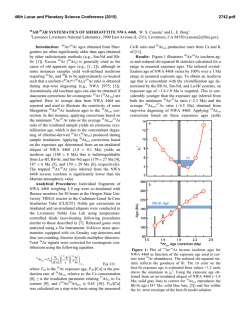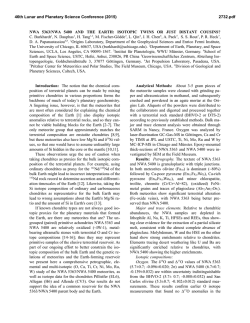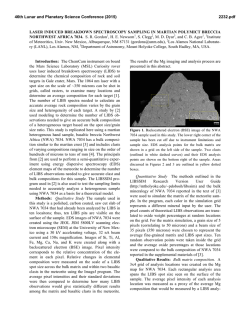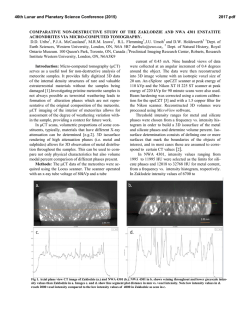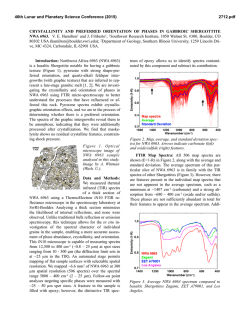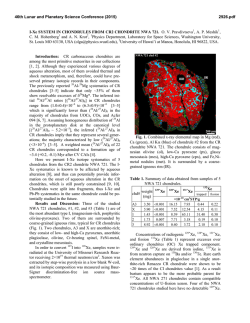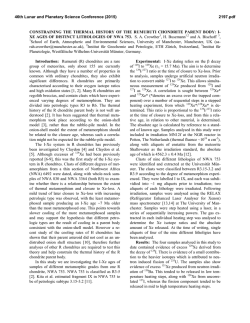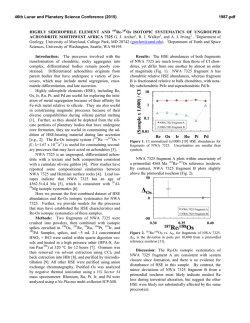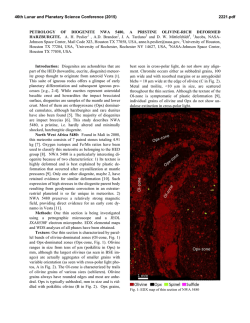
SECONDARY-VOLATILES LINKED METALLIC IRON IN EUCRITES
46th Lunar and Planetary Science Conference (2015) 2983.pdf SECONDARY-VOLATILES LINKED METALLIC IRON IN EUCRITES: THE COMPLEX CASE OF CAMEL DONGA. Paul H. Warren1 and Junko Isa1, 1Dept. Earth, Planetary & Space Sci., UCLA, Los Angeles, CA 90095-1567, USA; [email protected]. The recent discovery of enigmatic large, veinshaped masses of native Fe in NWA 5738, a eucrite with an extraordinarily diverse array of secondarymetasomatic alterations [1], has prompted interest in other Fe-metal rich eucrites. As described by Cleverly et al. [2] and [3], Camel Donga contains about 2.1 wt% (1 vol%) metallic iron. For the most part, this metal occurs as scattered small (<0.1 mm) grains of highpurity Fe composition: <0.05 wt% Ni according to [2], 0.058 wt% according to an INAA study of aggregated particles [3]. In our own study, from a typical sample (CD1), out of 35 scattered points analysed, 24 yielded results below our detection limit of 0.012 wt% (using high current and long count durations), and the other 11 average 0.03 wt%; the only consistently detectable impurity, Co, averages (N=35) 0.036 wt%. Palme et al. [3] developed an elegant model for origin of these pure-Fe metals by reduction, with most of the Fe deriving from reduction of the ferrosilite component of the rock’s pyroxene. These authors noted that bulk-rock data [cf. 2, 4] show no increase in Fe over the normal concentration (~ 144 mg/g) for a ferroan noncumulate eucrite, so they inferred that iron was reduced in situ, not added, by the secondary processing of this rock. As reducing agent, they suggested that S2 gas formed by decomposition of troilite (FeS) in a reheating episode, and then after combining with pyroxene-derived O, left the rock as SO2 gas. However, this simple pyroxene-reduction, SO2-loss model does not fit so well with more recent observations on Camel Donga. Two bulk analyses by [5] found higher Fe, 150 and 177 mg/g, and the latter result (significantly enriched vs. most noncumulate eucrites) came from a powder produced from an exceptionally large (1.8 g) mass of the meteorite. Also in contrast with earlier studies [2, 3], we have found that the compositional range for low-Ca pyroxene (again, using our “typical” sample CD1) extends up to mg = 51 mol%. This spread is somewhat enigmatic, because for the most part our results fall along a tie line between En41Wo2 opx and En32Wo43 augite [cf. 2, 3]. Still, the higher mg results imply that the rock’s bulk-silicate Fe must be slightly lower than previously supposed. We have also studied an additional sample of Camel Donga (CD2; unfortunately severely weathered) that is atypical inasmuch as it contains an 11-mm, sharpbounded, ovoid or lens-shaped nodule with vastly higher original metal content than the surrounding material (Fig. 1; nodule is rust-colored; black is fusion crust). The metal has mostly been altered to oxide, but the other phases in the nodule were not so greatly affected by the weathering. The nodule’s pyroxenes consistently have compositions along the aforementioned, typical-CD tie line (e.g., En41Wo2 opx); no extraordinary pyroxene reduction is evident in association with the extraordinary-high metal content. The CD2 nodule’s metal, and also the metals in a smaller tight cluster nearby (3 mm outside the nodule), have distinctively Ni-enriched compositions. For the nodule, 21 analyses avg. 0.525±0.009 wt% Ni and 0.040±0.007 wt% Co. For the nearby cluster, 5 analyses give practically identical averages. For 9 analyses of metals in the same CD2 thin section but far from the nodule, the averages are 0.064 wt% Ni and 0.044 wt% Co; more similar, although still not quite so pure-Fe, compared to our CD1 results (see above). Also, one of the bulk-rock analyses [4] shows Ni enrichment (38 µg/g). Such high Ni contents would be unprecedented in a eucrite free of impactor-debris “contamination”, and thus imply that not all of the Fe-metal in Camel Donga formed by simple in-situ reduction. The opaque oxides of Camel Donga (CD1) show surprisingly little evidence for involvement in the insitu reduction process. Margins as well as interiors of ilmenites show Fe-metal no more abundant than in the meteorite as a whole, and no rutile has yet been found. The spinels also appear unaffected, including in terms of mg, even at their rims. None of the Mg- and Cr-rich ilmenite that can form when spinel is reduced [6] has been found in Camel Donga. It seems mysterious that a brief, high-T redox episode would attack pyroxene while leaving FeO-rich oxides unmolested. Diffusion is much faster in oxides than in pyroxene [7-9]. In CD1, an aspect of similarity to NWA 5738 [1] was found in the form of a discontinuous, curvy vein of 46th Lunar and Planetary Science Conference (2015) anomalously Na-poor (An96) plagioclase within one of the larger pyroxenes. We suspect that Camel Donga is a product of a complex sequence of alterations that included, and may have begun with, localized mechanical admixture of impactor-debris “contamination”. In modeling NWA 5738, [1] noted that Dawn results have shown that the crust of Vesta (and by extension, for that matter, any basalt-crusted belt asteroid) appears to be remarkably rich in volatile-rich carbonaceouschrondritic matter that remains relatively intact through the accretion process (which is gentle, in this context, compared to more familiar Earth and Moon settings). Fluids emanating from such masses, when heated, are likely to be diverse initially and then evolve to even greater diversity, including redox diversity. Camel Donga may represent one, most highly reduced, end of a spectrum of eucrite secondary alteration scenarios that also includes extraordinarily oxidized materials, as found from spinel (and olivine) analyses for the most common variety of alteration veins in NWA 5738 [1]. Meanwhile, we have also studied (again using the stoikiometric methodology of [1]) spinel-olivine couplings in alteration veins of the Haraiya [10] and NWA 5073 [11] eucrites. Results indicate uncommonly high oxidation states (Fe3+ in spinel), by eucrite standards, although not so high as in NWA 5738. The link between such oxidized materials and sulfurized eucrites such as NWA 2339 [12], and to the troilitedecomposition mechanism proposed by [2], should be the subject of exciting further research. Aknowledgements: We thank the Smithsonian Institution and the University of Münster (Addi Bischoff) for the loan of Haraiya and NWA 5073 samples, respectively. References: [1] Warren P. H. et al. (2014) GCA 141, 199-227. [2] Cleverly W. H. et al. (1986) Meteoritics 21, 263-269. [3] Palme H. et al. (1988) Meteoritics 23, 49-57. [4] Barrat J. A. et al. (2000) MAPS 35, 10871100. [5] Isa J. et al. (2009) LPS abstr. #1919. [6] Taylor L. A. (2004) Am. Mineral. 89, 1617-1624. [7] Cherniak D. J. and Dimanov A. (2010) Rev. Mineral. Geochem. 72, 641–690. [8] Stenhouse I. et al. (2010) EGU General Assembly, p. 343. [9] Van Orman J. A. and Crispin K. L. (2010) Rev. Mineral. Geochem. 72, 757–825. [10] Schwartz J. M. and McCallum I. S. (2005) Am. Mineral. 90, 1871–1886. [11] Roszjar J. et al. (2011) MAPS 46, 1754–1773. [12] Zhang I-C. et al. (2013) GCA 109, 1-13. 2983.pdf
© Copyright 2026

